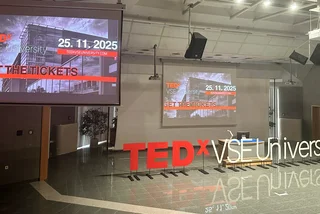Written by Terje B. Englund
Re-published with permission
Almost 50 years of totalitarian rule, when disgusting crimes were hailed as heroic actions while heroic actions where condemned as disgusting crimes (see: Horáková, Milada), have left the Czechs utterly suspicious of any officially “verified” explanation of the many dramatic events that have taken place in their country.
This widespread distrust has given rise to a wild array of historic myths. All of them have one common denominator: events that seem to have a simple and perfectly logical background are, in reality, the result of a conspiracy conducted by “dark forces”. This is not entirely inappropriate when it comes to the 1950s and early 1960s, when conspiracies evidently flourished. However, it´s more surprising that an event as relatively recent and significant as the Velvet Revolution in 1989 is also entangled in a mesh of myths.
According to the official version, the Velvet Revolution started on November the 17th , when the Socialist Youth Organization (SSM) arranged a demonstration in Prague´s Albertov district to commemorate Jan Opletal, a medic who was shot dead by the Nazi occupants in 1939. After some brief speeches, the students marched to Karel Hynek Mácha´s grave at Vyšehrad – and then towards the centre of Prague.
By the time they reached the end of the Národní Avenue, where special riot police forces blocked access to Wenceslas Square, the students were accompanied by tens of thousands of ordinary citizens, who peacefully chanted freedom slogans. Yet the Special Forces reacted with a brutality uncommon even to the Bolshevik regime. When the savage beatings ceased an hour later, nearly forty demonstrators had been rushed off to hospitals, and one student was even reported murdered by the police.
The violent action on the evening of November the 17th later became known as the “Massacre on the Národní Avenue” (a rather pathetic monument to commemorate the event has been installed in the arcade outside Národní 16). The word “massacre” may seem a bit exaggerated, since the only dead demonstrator, as it was established some days later, was actually a fake (although the alleged police murder served as an effective reminder of Jan Palach). Nevertheless, the regime´s brutal behaviour against defenceless students triggered a strike among Czech actors and subsequent demonstrations and civic protests in nearly every city and town in the country.
In the following days, the Bolsheviks were forced to renounce one privilege after another. After two weeks of mass demonstrations – some of them attended by almost one million Czechs – the regime collapsed entirely. “Love and truth” had finally defeated “lies and hate”, and the Czechs had added a bright – and much-needed – chapter to their modern history. Or was everything different? Visit any hospoda in this country, and you´ll probably hear another version. To quite a few Czechs, the Velvet Revolution was, in reality, a reform-communist putsch that failed.
One of the best “proofs” of this conspiracy theory is that the students, participating in the demonstrations on November the 17th were led to the centre of Prague by an agent from the secret police, or StB (see: Lustration) who acted as a radical SSM agitator (the agent´s presence was later documented). At Národní Avenue, the same secret agent supposedly played the role of the student who was beaten to death by the police. The purpose? To publicly discredit the orthodox leadership of the Czechoslovak Communist Party and thus help the Party´s reform wing gain power.
In other words, Czech secret police staged the Velvet Revolution with political backing from Soviet leader Mikhail Gorbachov and his reform-minded comrades in Czechoslovakia. Both the students and dissident movement (see: Charter 77) were exploited as unknowing instruments, but for some reason or other, the plot didn´t succeed.
An intense, but not particularly credible, spokesman for this theory is Miroslav Štěpán, Prague´s last Party boss (see: Communism). The much-hated Štěpán allegedly deposes witnesses who claim that Gorbachov´s private secretary Gennadij Gerasimov mentioned “the coming events in Czechoslovakia” one month in advance. The conspiracy theory is further based on the report that several KGB generals were supposed to have visited the Prague police´s operations centre on the 17th of November. Why would they, goes the argument, if the KGB and the Soviet reform communists didn´t orchestrate the demonstrations that went on in Prague´s streets?
No matter how intriguing these theories might sound, the evidence is next to nothing. True, KGB top brass did reportedly visit Prague in mid November, and, yes, the Czech secret police did infiltrate the student movement. But this, of course, doesn´t prove that the outbreak of the Velvet Revolution was directed from the Kremlin.
Another theory, which has spread to even more hospodas than the previous one, is that Václav Havel, during the negotiations that started a week after November the 17th, struck a secret deal with the communist leaders. Exactly what this deal was supposed to contain often depends on the intoxication level of the person propounding the theory, but one allegation seems to enjoy particularly strong support: the Havel-led opposition promised the communist bigwigs immunity if they were nice guys and left power without making any trouble. And then there are a host of conspiracy theories that can´t be described as anything other than downright insane, such as the notion that the Velvet Revolution was orchestrated by Zionists and freemasons (see: Karel Gott).
It´s puzzling, but the most obvious interpretation of the Velvet Revolution´s origin is the one most seldom heard: that the Velvet Revolution wasn´t a revolution at all, at least not in the traditional sense of the word. It was, rather, the collapse of a rotten regime.
Just look at the background: the communist regime didn´t receive their final blow on the 17th of November. Earlier that autumn, Hungary started to dismantle the Iron Curtain along its borders with Austria, and Prague was flooded with refugees from Eastern Germany on their way to the West. The air was virtually heavy with the scent of freedom. And then, one week before November the 17th, the Berlin wall – the most tangible symbol of Europe´s division – fell, and Big Brother in Moscow didn´t lift a finger (see: Russians).
Many bad and ugly things can rightfully be said about the Czechoslovak “normalizors”, but when it came to power politics, they were realistic. Even the moronic Party boss Milouš Jakeš understood that this time, no Soviet tanks would come and save them. They also knew they were too weak, morally corrupt and despised to stay in power on their own. If the student demonstration hadn´t triggered the communist collapse, it´s fairly safe to assume that some other event would have done the job.
Therefore, it might seem most appropriate to describe the Velvet Revolution as the climax of a long-lasting process that started with the uprising in Poland in the beginning of the 1980s, and then hit its stride when the new Soviet leadership abandoned the Brezhnev doctrine of propping up ideologically and economically bankrupt dictatorships in Central and Eastern Europe.
But, of course, this doesn´t change the fact that for millions of pestered Czechs, the Velvet Revolution represents one of the brightest moments of their lives.
Terje B. Englund is a Norwegian journalist, writer and translator. Educated at the University in Oslo and the Institute of Slavonic Studies at Charles University, he has been based in Prague since 1993, covering Central and Eastern Europe for Scandinavian media. Englund is an affectionate cyclist, mountaineer and diver, and he also enjoys the company of his French bulldog, Gaston.
“Czechs in a Nutshell” can be bought via Internet at www.baset.cz and in bookstores throughout Prague.












 Reading time: 6 minutes
Reading time: 6 minutes 



















